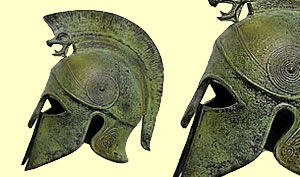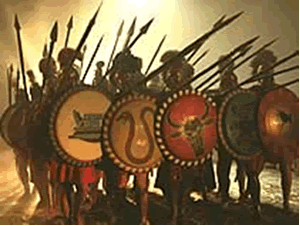Science of Conflict
Metallurgy |
Stone Age man
fashioned weapons from stone, bone and horn. Weapons to protect the tribe,
attack neighbouring tribes and hunt for food. Weapons included arrows,
daggers, spears and clubs.
A tribe's dominance was inextricably
linked to innovation and good fortune. Innovation to make the most of
what was available and good fortune came down to availability of resources.
Resources that made a significant difference were deposits of metals.
Tribes with easy access to metal resources soon gained dominance. |
|
|
Metals have a distinct advantage
over wooden weapons. Cultures that were able to master metal technology
had a superior advantage. Metals have unique
properties , they are hard and strong and can be bent to different
shapes. Copper was the first metal of importance. It is found as an ore
from which the pure metal must be extracted. Extraction of copper presented
many challenges one of which was to produce heat of around 800 oC
to 1000 oC in order to melt, shape and mould the pure metal.
Smelting was accomplished initially in an open fire. A hole 40 to 50 cm
in diameter was dug in the ground. The hole was lined with fire-resistant
clay or stone. Charcoal was placed in a layer on top of the clay and was
later covered by copper ore. Burning charcoal can create temperatures
sufficient to melt copper, but charcoal also releases gases that react
with the carbonates and sulfur that is found in some compounds. A molten
mass of dense copper would form, covered with lighter waste products called
slag. Once cool the glassy slag could be broken off to get to the pure
copper underneath..
|
Pure
copper is too soft to be used in the making of weapons and armor. Around
5000 BC. it was discovered that if 10 to 15 percent of the copper is replaced
by tin, the resultant bronze metal is both stronger and harder and ultimately
better for weapon manufacture than pure copper. Bronze was the first man
made-alloy and quickly revolutionised the production of weapons and armor.
Flint quickly gave way to bronze in the use of spears and arrows.
|
| During the persian invasion
of Athens, during the fifth century BC. scientists loyal to Athens went
to work to give the city state a technological advantage over the more powerful
and overwhelming Persian forces. In 490 BC. the persian army encountered
the Athenian army in a plain near Marathon. Persian infantry wore no armor
as they had hoped to mop up any small resistance that was left after the
Athenians were decimated by the Persian archers. Confidence soon turned
to shock as the Persian arrows simply bounced off the bronze armor worn
by the Athenians. |
|
| The Greek bronzesmiths developed
a new bronze body armor that featured a helmet with nose, cheek and neck
protection, greaves for leg protection and a strong light weight shield. |
|
| Around the same
time as bronze was becoming fashionable brass also made its debut. Brass
is made from copper and zinc and is softer than bronze. Although not as
useful for the manufacture of weapons, brass was widely used for domestic
purposes. Since tin was a necessary ingredient of bronze, populations that
had settled close to deposits of tin prospered either by the manufacture
of weapons or trade. |
|
|
|
|


